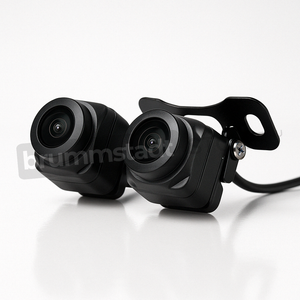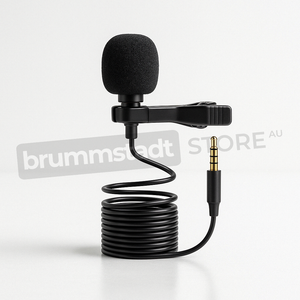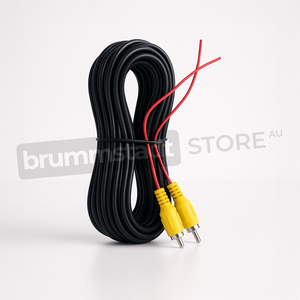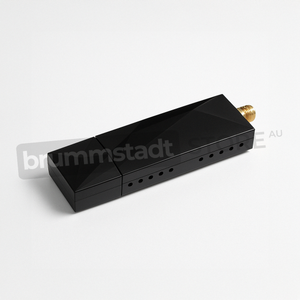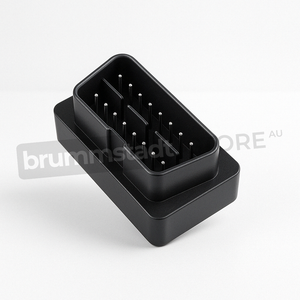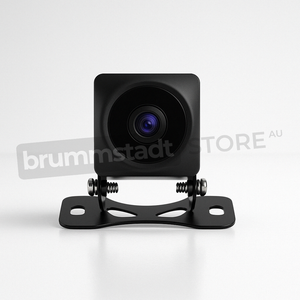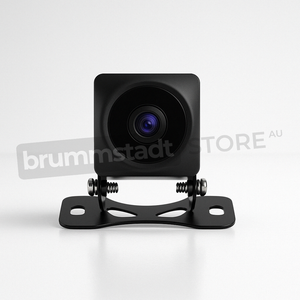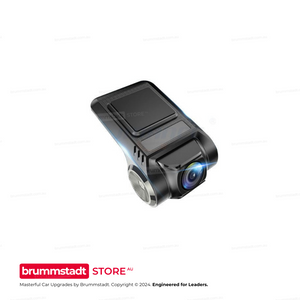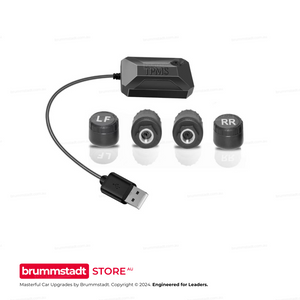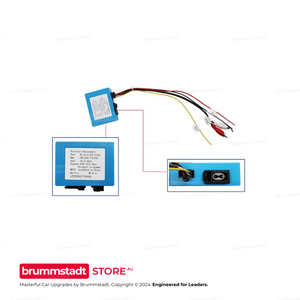Frequently Asked Questions
Everything you need to know about this head unit
Connect the single RCA cable with the yellow plug (included in your package) to extend your Bluetooth signal. This cable doubles as both a camera input AND a Bluetooth/WiFi antenna extension. The two small blue wires attached are antenna boosters that significantly improve connection stability. This simple connection takes 30 seconds and resolves 90% of Bluetooth issues. Make sure it's firmly connected even if you're not using a rear camera.
Try these proven solutions:
1. Quick Fix: Settings → Apps → Z-Link → Disable → Enable → Open (repeat each use)
2. Check Cables: Use the data/charge USB cable (not charge-only)
3. Bluetooth Setting: Disconnect all other Bluetooth connections - CarPlay needs exclusive access
4. Factory Reset Z-Link: Find the pink 'RESET' app, restart, reconnect Bluetooth, then try Z-Link
5. Sound Issues: Switch audio source to 'AUX' or 'USB/AUX' in your vehicle menu
Most issues are resolved with step 1 or 3!
The processor differs between models: The 2/32GB has a 4-Core processor, while 4/64GB and 8/128GB models feature the powerful 8-Core Cortex-A55 processor. Combined with RAM differences: The 2/32GB model with its 4-Core processor and limited RAM may experience slowdowns with heavy multitasking. The 4/64GB with 8-Core provides smooth performance for most users - no lag, seamless app switching, and enough storage for maps and music. The 8/128GB with 8-Core offers maximum performance with its generous RAM allowing unlimited multitasking and massive storage for extensive media libraries. Think of RAM like your desk space - more RAM means you can have more apps open simultaneously without slowing down.
Absolutely normal! These head units are complete replacement systems with their own GPS antenna, microphone, and Bluetooth module. Your factory connectors for these features won't be needed anymore. The important connections are: main power harness, speaker outputs, and the yellow RCA cable (even if not using a camera - it extends Bluetooth range). Any leftover factory plugs can be safely tucked away. If you're unsure about any connection, our support team is here 7 days a week.
Z-Link updates are handled through system firmware updates. Go to Settings → System → System Update. If an update is available, download it to a USB drive (FAT32 format) and install. Important: Never download Z-Link APKs from unofficial sources - they won't work and may cause issues. If you're having compatibility issues with newer iOS versions, the disable/enable workaround (Settings → Apps → Z-Link) usually resolves them while waiting for official updates.
Consider your usage:
• 2/32GB (4-Core): Budget option - fine for basic use, but may lag with multiple apps due to 4-Core processor and limited RAM
• 4/64GB (8-Core): Sweet spot - smooth Android Auto/CarPlay, multitasking, and ample storage
• 8/128GB (8-Core): Premium choice - unlimited multitasking, massive storage, future-proof for years
Most customers choose 4/64GB for the perfect balance of performance and value. The extra RAM makes a huge difference in daily smoothness!
The yellow RCA cable's blue antenna wires also boost WiFi signal! Make sure this cable is connected. Additionally, try these tips: Position the blue antenna wires away from metal surfaces, check that your phone's hotspot is set to 2.4GHz (not 5GHz) for better range, and ensure the head unit's WiFi sleep policy is set to 'Never' in Settings → WiFi → Advanced. For best performance with wireless CarPlay, keep your phone within 1-2 meters of the head unit.
Go to Settings → Sound → Equalizer and adjust to your preference. For more volume, increase the 'Loudness' setting. The 4/64GB and 8/128GB models have superior audio chips that provide cleaner, louder sound. If you have an amplifier, use the RCA outputs for best quality. Also check Settings → Factory Settings (password usually 126) → Audio settings for additional gain controls. Remember: higher-spec models (4GB+) include premium audio components for noticeably better sound.
Yes! Most vehicles work instantly. If not, use the steering wheel learning app: tap the steering wheel icon, press each button on your wheel, and assign functions. For newer vehicles with CANbus, we provide CANbus modules for automatic setup. Some vehicles may need the Key1/Key2 wires connected (usually included in our harness). If you're having trouble, let us know your exact vehicle model and we'll provide specific instructions.
We offer a 30-day return policy. If it doesn't fit or there's a compatibility issue, we'll work with you to resolve it. If you change your mind, a 20% restocking fee applies. Our team verifies compatibility before shipping to minimize issues. We provide installation support 7 days a week to help resolve any problems. With our 3-year warranty and Australian-based support, you can purchase with confidence. Full details in our Refund Policy.
Historical Evolution of the Toyota Corolla Model Series:
First Generation Corolla (E10, 1966-1970):
The Corolla journey commenced in 1966 as Toyota's compact and economical offering, delivering affordability matched with commendable reliability. Swiftly gaining popularity throughout Japan, Europe, North America, and Australia, the early Corolla stood out for functional simplicity, fuel efficiency, and solid engineering, providing everyday drivers with reliable transportation.
Second Generation (E20, 1970-1974):
As the Corolla's popularity flourished, Toyota refined and expanded the platform. A widened range included coupes, sedans, and wagons, all showcasing improved comfort, enhanced performance, and greater versatility. This era introduced significant improvements in safety and ride refinement, building widespread customer appreciation worldwide.
Third and Fourth Generations (E30/E40 and E70, 1974-1983):
Through the '70s and early '80s, Corolla matured further as a practical, fuel-efficient vehicle that aligned perfectly with global economic sensibilities. Notably, the rear-wheel-drive E70 established Corolla as consistently dependable in daily commutes worldwide, significantly bolstering both brand loyalty and consumer trust.
Fifth and Sixth Generations (E80, 1983-1987; E90, 1987-1992):
The transition to front-wheel drive around the mid-1980s marked a vital phase in Corolla’s evolution. Each edition further improved cabin comfort, handling, economy, and reliability. The sixth generation (E90) captured particular admiration thanks to thoughtful cabin design and superior ergonomics, solidifying its reputation as an automotive staple internationally.
Seventh and Eighth Generations (E100, 1992-1997; E110, 1997-2002):
By the 1990s, Corolla had developed into a very comfortable and reliable family-oriented vehicle well-suited to global markets. The seventh and eighth generations featured marked advances in internal comfort, safety equipment, and more responsive engines, becoming preferred choices for those valuing consistency, economy, and comfort.
Ninth Generation (E120/E130, 2002-2007):
The Corolla's expansion in global appeal reached another peak with the ninth generation when distinct European hatchback versions offered sportier, refined characteristics distinctly appealing to regions worldwide. Enhanced handling, thoughtful design elements, and improved powertrain options increased further global admiration and broadened the Corolla's consumer loyalty base considerably.
Tenth Generation Corolla Hatchback/Auris (E150, 2007-2011):
The 2007-2011 Corolla hatchback, rebranded as the Toyota Auris for European and select global markets including Australia, represented a direct continuation of Corolla's comprehensive reinvention. Positioned specifically to cater to European aesthetics and driving preferences, the Auris introduced a sleek, contemporary design with an elevated interior quality and significantly increased cabin refinement.
The Auris excelled through its selection of more efficient petrol and diesel engines and intuitive handling dynamics, paired effectively with practical everyday utility. It quickly became favored across markets for its reassuring practicality, spaciousness in a compact footprint, balanced performance, and enduring build quality.
Advantages Offered by the 2007-2011 Toyota Corolla Hatchback (Auris):
Design and Comfort:
The Corolla Hatchback/Auris impressed customers through a pleasantly refined interior, improved passenger ergonomics, and class-competitive cabin isolation. Subtle yet attractive exterior styling made this iteration approachable yet sophisticated, resonating broadly with diverse global audiences.
Performance and Efficiency:
With available engines ranging from fuel-conscious 1.4L petrol and diesel options to energetic 1.8L petrol variants, Toyota gave drivers ample choice. Carefully balanced suspension tuning alongside efficient, compliant handling made urban commuting comfortable while providing confident handling for longer journeys.
Reliability and Safety Focus:
Toyota persisted in its unwavering dedication to robust, durable build quality. Safety technology including multiple airbags, improved braking and stability control systems underscored the Auris' attractiveness as a dependable, trusted daily transport.
Expanding the Corolla Hatchback/Auris driving experience can thoughtfully be addressed through aftermarket integration of appropriate technology upgrades. Brummstadt offers precisely such tailored head units, designed specifically to fit seamlessly within the 2007-2011 Corolla dashboard architecture. This premium infotainment upgrade introduces thoughtfully integrated modern connectivity features readily accessible to Corolla/Auris drivers.
These advanced units support both wired and wireless Apple CarPlay and Android Auto integration, immediately broadening the possibilities for everyday navigation, communication, and entertainment. Drivers benefit significantly when native support for applications such as Apple Maps, Google Maps, and WAZE enables convenient, straightforward travel planning. For instance, after finishing a relaxed family dinner out, users simply preselect their next destination via a smartphone—the navigation quickly and smoothly transitions onto the head unit's screen through Apple CarPlay or Android Auto. This streamlined process ensures stress-free, confident journeys in unfamiliar or busy traffic scenarios.
Additionally, an upgrade option expands the head unit’s capability with front and rear-mounted full HD 1080p cameras. These cameras elevate practical aspects of driving by enhancing visibility and proving valuable during parking and navigating urban spaces; their ability to cyclically record enhances safety and security.
Furthermore, the Brummstadt head unit offers a playful edge to long family drives by allowing gaming controllers via connected USB instances, transforming idle passenger time into cheerful, shared gaming moments. Also notable is built-in smart voice control compatibility with popular virtual assistants (such as Apple's Siri), streamlining direct interaction for entertainment, navigation, and even domestic smart-home functions (for example, remotely activating home lighting prior to arrival), offering added convenience and reassurance beyond the immediate driving experience.
Overall Benefits and Advantages:
The Toyota Corolla Hatchback/Auris from 2007-2011 stands as an intelligent melding of practicality, style, efficiency, and trusted reliability. This generation attests to Toyota's patient refinement of engineering, creating an approachable yet sophisticated option for drivers across the spectrum—urban commuters, families, and practical-minded car owners alike.
Choosing a thoughtfully engineered aftermarket infotainment upgrade such as Brummstadt’s enriches this platform significantly, extending convenience, practical usability, and engaging entertainment throughout every drive. Such thoughtful additions embody not merely functionality but contribute directly to driver satisfaction, overall vehicle ownership pride, and sustained appreciation of a genuinely well-crafted automotive experience.














